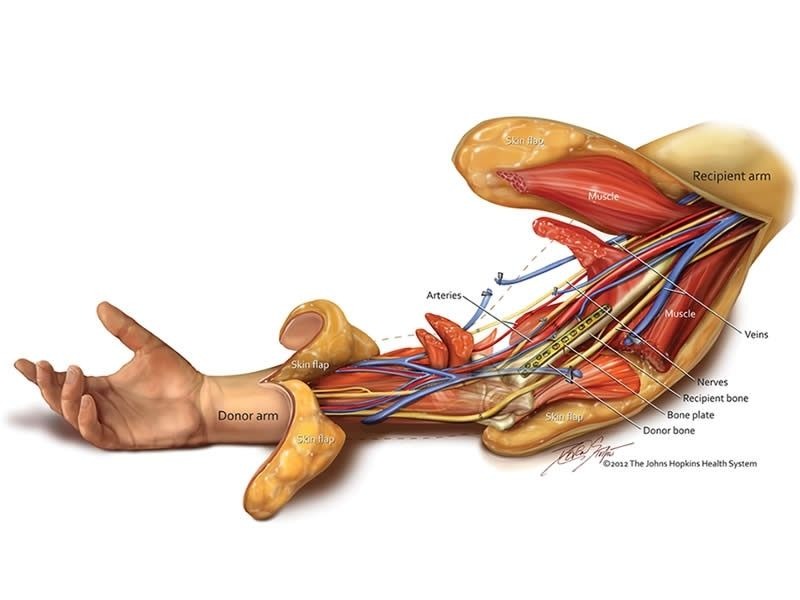 Arm transplant surgeries have made significant progress, especially as composite tissue transplants. These interventions, which we encounter as reconstructive surgery, bring with them really important material differences in the points they reach. In this context, it is the transplantation of tissues such as arm and leg transplants, face and scalp transplants, uterus, muscles, nerves and tendons, which are called extremity transplants, from a brain dead corpse to a living patient. The main technique in the surgery of these transported tissues is the use of microsurgical applications. In addition to being surgically difficult operations, these operations include some important medical practices that must be followed for the patient’s life in the postoperative period. Naturally transplanted tissue has a high tendency to reject it because it is foreign to the recipient body. The recipient’s immune system engages in constant battle with these tissues. If the immune system is not suppressed, the body rejects this transplanted organ and causes tissue loss. Suppressor drugs used in visceral transplant patients are also significantly used in arm transplant surgeries. We can say that these surgical interventions, which today are particularly on the agenda of the University of Akdeniz, offer great benefits to people and show us the stages of the surgical processes. Therefore, like kidney and liver transplant patients, arm transplants vary considerably and affect everyone directly. For this reason, heart, kidney and liver transplant patients themselves must take drugs that suppress the immune system in these patients. However, these drugs are by no means innocent and can cause serious problems like cancer and life-threatening opportunistic infections in the future. For this reason, patients should undergo a very detailed investigation before performing surgery such as liver and kidney, which are not essential for life, such as face and extremity transplantation, which must increase the patient’s functions and provide an aesthetic gain. To the patient who will be placed on the waiting list for limb transplantation; Interviews involving more than one branch are performed before surgery, psychiatric evaluation, haematological and microbiological evaluation, anesthetic evaluation, immunological evaluation and psychosocial evaluation. The patient and his relatives are informed and informed about the procedures. Information is provided on possible processes to be experienced after surgery. In our country, the criteria for the distribution of donated organs and tissues of a person with brain death have been determined by the Ministry of Health. According to these criteria, the most appropriate organs and tissues are distributed equally to the most medically appropriate patient. In extremity transplants; Blood group compatibility and gender compatibility between donor and recipient are the most basic criteria. In addition to these, patient selection is made based on objective data such as skin color compatibility and patient waiting time. It is not possible to say anything precise about the average waiting time on the waiting list. If there is a suitable recipient for the organ provided in the match, the transplant process is performed.
Arm transplant surgeries have made significant progress, especially as composite tissue transplants. These interventions, which we encounter as reconstructive surgery, bring with them really important material differences in the points they reach. In this context, it is the transplantation of tissues such as arm and leg transplants, face and scalp transplants, uterus, muscles, nerves and tendons, which are called extremity transplants, from a brain dead corpse to a living patient. The main technique in the surgery of these transported tissues is the use of microsurgical applications. In addition to being surgically difficult operations, these operations include some important medical practices that must be followed for the patient’s life in the postoperative period. Naturally transplanted tissue has a high tendency to reject it because it is foreign to the recipient body. The recipient’s immune system engages in constant battle with these tissues. If the immune system is not suppressed, the body rejects this transplanted organ and causes tissue loss. Suppressor drugs used in visceral transplant patients are also significantly used in arm transplant surgeries. We can say that these surgical interventions, which today are particularly on the agenda of the University of Akdeniz, offer great benefits to people and show us the stages of the surgical processes. Therefore, like kidney and liver transplant patients, arm transplants vary considerably and affect everyone directly. For this reason, heart, kidney and liver transplant patients themselves must take drugs that suppress the immune system in these patients. However, these drugs are by no means innocent and can cause serious problems like cancer and life-threatening opportunistic infections in the future. For this reason, patients should undergo a very detailed investigation before performing surgery such as liver and kidney, which are not essential for life, such as face and extremity transplantation, which must increase the patient’s functions and provide an aesthetic gain. To the patient who will be placed on the waiting list for limb transplantation; Interviews involving more than one branch are performed before surgery, psychiatric evaluation, haematological and microbiological evaluation, anesthetic evaluation, immunological evaluation and psychosocial evaluation. The patient and his relatives are informed and informed about the procedures. Information is provided on possible processes to be experienced after surgery. In our country, the criteria for the distribution of donated organs and tissues of a person with brain death have been determined by the Ministry of Health. According to these criteria, the most appropriate organs and tissues are distributed equally to the most medically appropriate patient. In extremity transplants; Blood group compatibility and gender compatibility between donor and recipient are the most basic criteria. In addition to these, patient selection is made based on objective data such as skin color compatibility and patient waiting time. It is not possible to say anything precise about the average waiting time on the waiting list. If there is a suitable recipient for the organ provided in the match, the transplant process is performed.



